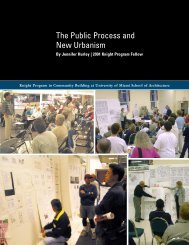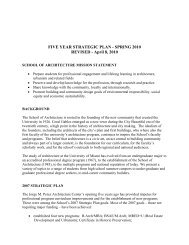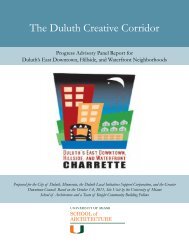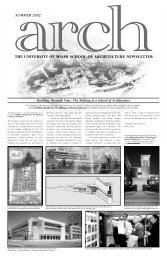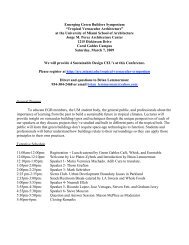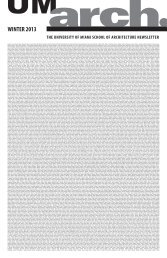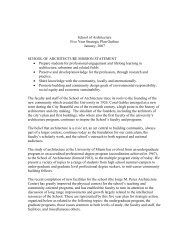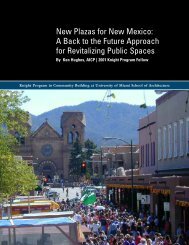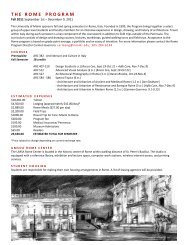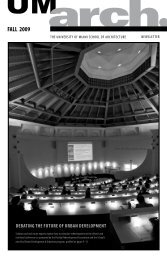Resilience - University of Miami School of Architecture
Resilience - University of Miami School of Architecture
Resilience - University of Miami School of Architecture
You also want an ePaper? Increase the reach of your titles
YUMPU automatically turns print PDFs into web optimized ePapers that Google loves.
<strong>Miami</strong>-Dade Water & Sewer<br />
5.<br />
Planning Context<br />
Federal Agencies<br />
<strong>Miami</strong>-Dade <strong>School</strong>s<br />
<strong>University</strong> <strong>of</strong> <strong>Miami</strong><br />
City or County Parks<br />
1. Land ownership<br />
land ownership<br />
The most immediately applicable planning documents are the campus master<br />
plans completed by the <strong>University</strong> <strong>of</strong> <strong>Miami</strong>. Before referencing those it<br />
is important to consider the context <strong>of</strong> Virginia Key as a whole, and its contribuon<br />
to the general urban context. The site is located in unincorporated<br />
<strong>Miami</strong>-Dade County, and is listed as unzoned. With excepon <strong>of</strong> the federally<br />
owned parcels across the causeway, all the land surrounding the campus, including<br />
the Seaquarium site is owned by the <strong>Miami</strong>-Dade Parks and Recreaon<br />
department. The causeway is owned by the County as well. The wastewater<br />
treatment plant is owned by <strong>Miami</strong> Dade Water and Sewer. However, the City<br />
<strong>of</strong> <strong>Miami</strong> owns all the coastal land north <strong>of</strong> the causeway including the former<br />
landfill to the north, Virginia Key Beach Park, and the Marine Stadium site (figure<br />
1).<br />
county comprehensive plan<br />
All land in the county is covered by the Comprehensive development Master<br />
Plan (CDMP). Several elements <strong>of</strong> the plan have parcular relevance to Virginia<br />
Key. Perhaps the most impacul is the introducon to the Conservaon<br />
element <strong>of</strong> the plan which states “The environmental sensivity <strong>of</strong> <strong>Miami</strong>-<br />
Dade county is underscored by the fact that urban poron lies between two<br />
naonal parks Everglades and Biscayne” (<strong>Miami</strong>-Dade, CDMP IV-1). This sec-<br />
on also emphasizes the economic importance <strong>of</strong> environmental protecon in<br />
light <strong>of</strong> the County’s reliance on tourism. The Coastal Management Element<br />
emphasizes restoraon <strong>of</strong> coastal habitat, especially in areas which are poten-<br />
al habitat corridors. Increasing public waterfront access is also menoned<br />
(VI-9). The designated land uses for 2015 to 2025 are indicated in figure 2. The<br />
RSMAS site is designated for instuonal use, but most <strong>of</strong> the island is designated<br />
for parks and recreaon or environmentally protected park.<br />
2. 2015 Land Use Plan, <strong>Miami</strong>-Dade County<br />
19




